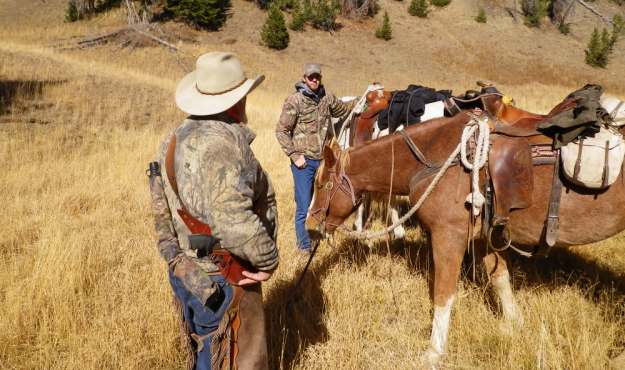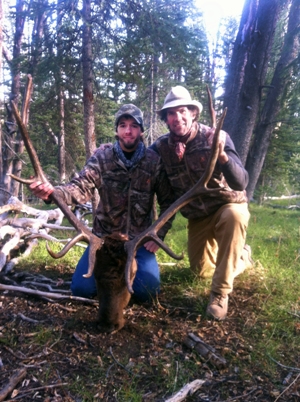
I was hunting with a friend of mine at the headwaters of the Yellowstone River in northern Wyoming. My friend got his ram early in the hunt. So, we broke camp, packed up and headed to a place where we wanted to try and take an elk. We set up another camp at about 3 to 4 in the afternoon, got on our horses and rode a little way into the mountains. But the terrain became so rough that we had to tie our horses and crawl up on top of the mountain range. The first thing we saw was a big thunderstorm coming our way. In practically no time, we heard thunder, hail started pouring down on us, and we could hear some bugling off in the distance. Although I didn’t bugle back or cow call, because I felt certain that the bull wouldn’t hear me, we decided to head out to the direction where the sound of the bugling had come. We spotted a nice 4x5 bull beating up on a small sapling. Apparently, he was trying to scrub off some of the velvet from his antlers. When we were about 40 yards from the bull, I did a little cow calling, and the bull started coming straight toward us. At that time, I was shooting a Hoyt bow. Next the elk began to quarter away from us - about 30 to 40 yards out. Then he came in so quickly I didn’t have a chance to range him. I hit him a little far back from the lungs, but I didn’t hit any of the ribs or the paunch area. I was really surprised when the bull trotted off about 30 yards and then went down. However, when I started field dressing the bull, I saw my broadhead had cut one of the elk’s main arteries.
 By then the time was almost dark thirty. I hated to leave a bull or any animal in that country overnight, because a number of grizzly bears were in the area and also wolves. So, I was really worried about leaving my meat out, but we really didn’t have an option. We went back down to camp. The next morning, we found a small trail that we could get the mules and horses on and close enough to pack the elk out.
By then the time was almost dark thirty. I hated to leave a bull or any animal in that country overnight, because a number of grizzly bears were in the area and also wolves. So, I was really worried about leaving my meat out, but we really didn’t have an option. We went back down to camp. The next morning, we found a small trail that we could get the mules and horses on and close enough to pack the elk out.
When we returned to camp, we put the meat in game bags to protect it from flies and bugs, and we used a game pole to get the meat up and off the ground. The weather was cool enough that the meat didn’t spoil, since at night, the temperatures were close to or at freezing. Generally, in the high country, the weather is cool enough, so that we don’t have to worry about the meat spoiling before we can get to a place where we can refrigerate it.
We usually dedicate about 10 days to a back-country elk hunt. But when we get an elk down, and cut up the meat and cool it down, we usually return to the trail head, load our meat up and take it back to one of the ranches where we know the rancher. Most of those ranchers have meat lockers, and they don’t mind letting us store our elk in their meat lockers until we break camp. Or, we’ll carry out the meat to the closest town to a meat processor. Often the decision we make on when to get the meat out is weather driven. If the weather is staying in the 30s all day long, or if the area where we are is having a snowstorm, we may let the meat hang on the meat pole for several days. Most of the time, we’re hunting between 8,000 and 10,000 feet of elevation and generally get plenty of cold weather. So, letting the meat hang for several days is often not a problem. What made this hunt so special was we endured rain, sleet, thunder and a good hike in that kind of weather to get in close enough for me to take a shot with my bow.




























